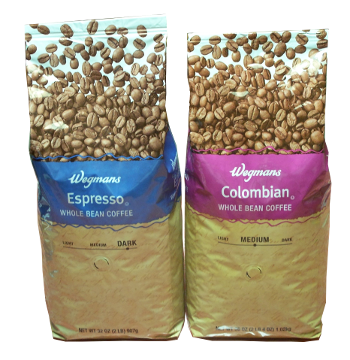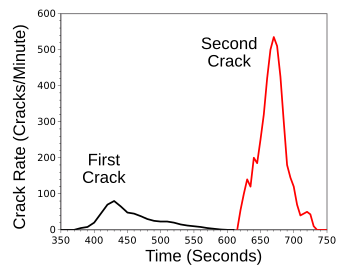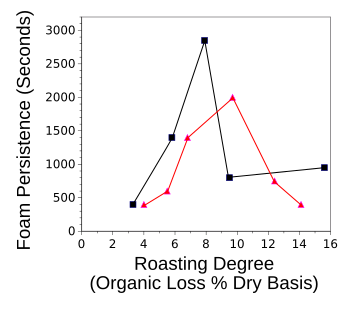Coffee Acoustics and Espresso Foam
October 31, 2016
While
taste and
smell are the primary
senses used for
quality control in the
kitchen, the other senses are used as well. The sense of
touch is used when you depress the center of a
cake to test for doneness, and
sight to determine when you've entered the
Maillard reaction stage. And then there's
hearing.

My favorite example of the Maillard reaction.
These are Polish chruściki, usually made for Christmas.
(Wikimedia Commons photo by Blazej Pieczynski.)
If you listen beyond all the
machine noises, there are some useful kitchen
acoustics. Hearing is used in the kitchen when checking the progress of
baked bread, where a nice "thump" when tapping with a
spoon indicates doneness. The
temperature of
fry oil is often tested by the sound made when a
droplet of
batter is placed in the
pan. One beloved kitchen sound is the pop of
popcorn, with the initial pop and last pop signalling critical stages in the process.
A 2014 study, and recent follow-up
research, by
mechanical engineers at the
University of Texas at Austin looked at an acoustic method of quality control in
coffee roasting.[1-3] Just as popcorn pops,
coffee beans will crack while being roasted, and experienced coffee roasters listen for these sounds to monitor the roasting process. As we all know, and as I've discussed in a
recent article (The Future of Work, March 3, 2016), most
jobs will be
automated by
mid-century, and this research points to a way to either lighten a coffee roaster's workload, or put him out of work, depending on
management whim.

As I've found, the key to good coffee is grinding your own beans, and storing bags of coffee beans in the freezer once they've been opened.
You don't need expensive beans - Supermarket beans make wonderful coffee. I mix these beans for my personal blend.
(Photo by author.)
At the end of the coffee roasting process, two distinctive sounds are emitted; namely, a low
frequency, high
amplitude first crack, followed later by a higher frequency, lower amplitude
second crack. Also, the popping
rate of the
second crack is higher.[1-2] The
second crack signals the breakdown of
cellulose in the coffee beans, the release of oils, and a resultant darker roast.[3] If heating is stopped soon after the
first crack, the result is a highly
acid light roast. Somewhat longer heating after the
first crack allows
sugars to
caramelize.[3]
In the UTA
experiments, sounds were recorded from 62
first crack events and 241
second crack events while roasting
espresso blend beans in a home roaster.[3] It was found that the
first crack is 15% louder than the second, it occurs at about five
octaves lower frequency, with a popping rate just a fifth of the second. Some
audio analysis software could easily differentiate between the two.[2]

Roasted coffee bean crack rate.
The second crack is easily distinguished.
(Graphed from data in fig. 3 of ref. 1 using Gnumeric.)[1])
More than a billion servings of coffee are brewed each day worldwide, with the
United States responsible for about 400 million
cups. It's estimated that about a quarter of coffee consumed is
espresso. One reason for this is that it's the base coffee for such popular drinks as
caffè latte,
cappuccino,
caffè macchiato, and
caffè mocha. Espresso is typically made from
dark roast coffee having a considerable concentration of coffee oils.
Espresso is brewed by forcing
high pressure hot
water through finely ground and
compacted (tamped) coffee. This process results in a thick beverage of
dissolved and
solid materials, with the oils forming a
colloid. This colloid is evident by a surface
foam called the
crema, and experienced
baristas note the appearance of the crema for quality control of the espresso-making process.

Crema on a cup of espresso coffee.
Baristas often stir an espresso to give a pleasing appearance, as shown.
(Modified Wikimedia Commons image by HSwaff.)
In 2011,
Researchers from
Illycaffè S.p.A,
Trieste, Italy,
published a
review article on espresso coffee foam.[4] As they stated in their article, "Only recently, some aspects of the
Physics and
Chemistry behind the espresso coffee foam have attracted the attention of
scientists."[4] As they found,
carbon dioxide generated by roasting is an important factor, and the quality of the crema depends on the quantity of carbon dioxide generated and the influence of coffee
compounds.[4]
The importance of carbon dioxide is such that "espresso brewing can be described as "a quick way to transfer carbon dioxide from roasted and ground coffee to a small cup by means of hot water under pressure."[4] The important factors are therefore,[4]
• The carbon dioxide generated by roasting.
• Maintaining the carbon dioxide in the bean by proper
packaging.
• Maintaining the carbon dioxide in the ground coffee.
• Solubilizing the carbon dioxide in water.
• Releasing the carbon dioxide into the beverage.
As the review
authors conclude, the foam
volume and
persistence (see figure) are the consequences of the carbon dioxide present in the coffee, with roasting and preparation aiding its release into the beverage. The carbon dioxide content and lipid content appear to be more relevant than coffee species for foam creation and foam stability.[4]

Espresso foam persistence as a function of roasting degree.
Triangles are pure Arabica, and squares are pure Robusta.
(Graphed from data in fig. 7 of ref. 4 using Gnumeric.)[4])
![]()
References:
- Preston S. Wilson, "Coffee roasting acoustics," J. Acoust. Soc. Am., vol. 135, no. 6 (June, 2014), article no. EL265, DOI: 10.1121/1.4874355. This is an open access publication with a PDF file available at the same link.
- Jay R. Johnson, Preston S Wilson, "Additional studies of the acoustics of coffee roasting," J. Acoust. Soc. Am., vol. 139, no. 4 (April, 2016), pp. 2165-2165, DOI: 10.1121/1.4950420.
- How to Roast Coffee by Ear, APS News, vol. 25, no. 8 (August/September, 2016). A PDF file is available here.
- Ernesto Illy and Luciano Navarini, "Neglected Food Bubbles: The Espresso Coffee Foam," Food Biophysics, vol. 6, no. 3 (September, 2011), pp. 335-348, DOI: 10.1007/s11483-011-9220-5. This is an open access publication with a PDF file available at the same link.
Permanent Link to this article
Linked Keywords: Sense; taste; smell; quality control; kitchen; touch; cake; sight; Maillard reaction; hearing; Poland; Polish; angel wings; chruściki; Christmas; Wikimedia Commons; Blazej Pieczynski; background noise; machine noise; acoustics; baking; bake; bread; spoon; temperature; frying; fry; oil; droplet; batter; pan; popcorn; research; mechanical engineer; University of Texas at Austin; coffee; roasting; coffee bean; job; automation; automate; 2050; mid-century; management; mill; grind; grinding; storage; storing; freezer; supermarket; frequency; amplitude; speed; rate; cellulose; acid; sugars; caramelization; caramelize; experiment; espresso; octave; audio analysis; software; roasting; roasted; Gnumeric; United States; coffee cup; espresso; caffè latte; cappuccino; caffè macchiato; caffè mocha; dark roast coffee; high pressure; water; compactor; compact; dissolution; dissolve; solid; material; colloid; foam; crema; barista; researcher; Illycaffè S.p.A; Trieste, Italy; scientific literature; publish; review article; physics; chemistry; scientist; carbon dioxide; chemical compound; solubility; solubilizie; author; volume; persist; persistence; function; triangle; coffea arabica; square; robusta coffee.